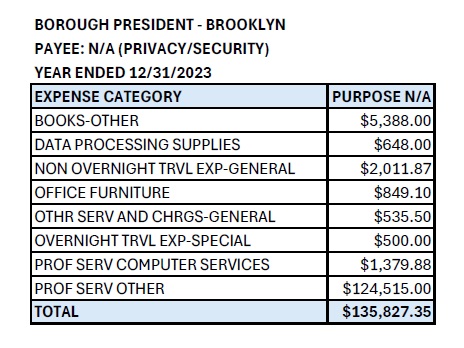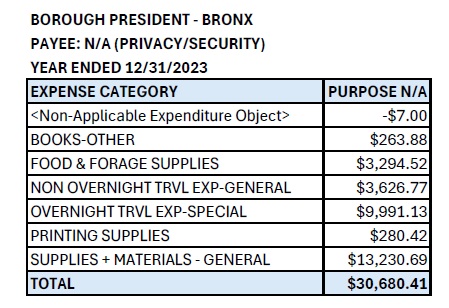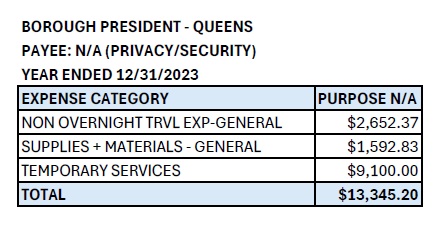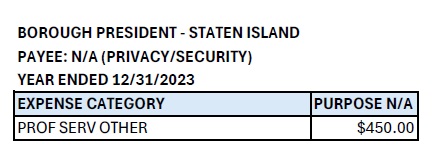Part 3 of “NYC’s Creative Accounting Chronicles” – Following “Fiscal Follies: Unveiling NYC Officials’ Creative Accounting Circus” and “NYC’s Financial Circus Continues: Board of Elections’ $29M Car Service Splurge“
Introducing Our Latest Discovery
Welcome to New York City’s most impressive disappearing act yet. Following our previous exposés of fiscal acrobatics and car service extravaganzas, we present something remarkable: $4.2 billion of taxpayer money that’s simply vanished from public view.
In what could be called innovative municipal recordkeeping, New York City has classified an astounding $4,201,873,479.51 under the vendor code “N/A (Privacy/Security)” in 2023. Of this impressive sum, $4,131,414,624.59 lists its purpose as “blank” – presumably because even “N/A” felt too specific. The remaining $70,458,854.92 gets the slightly more descriptive purpose of “N/A,” for those times when someone felt compelled to write something.
A sum of $4.2 billion is almost too massive to comprehend, let alone cover in a single post. So, let’s start small – with our borough presidents, whose modest contributions to this trend are particularly telling. After all, if routine expenses like office supplies and travel can be deemed too sensitive for public disclosure, what hope do we have of understanding the billions classified elsewhere? These smaller examples reveal a culture of opacity that has trickled down from the highest levels of city government to the most mundane of expenses.
Our Borough Presidents’ Contributions
Before examining the citywide phenomenon, let’s review how our five borough presidents have embraced this trend of selective transparency.
Brooklyn: The Pioneer
Borough President Antonio Reynoso leads with $135,827.35 in classified spending. His office’s signature move? Converting $124,515 into “Professional Services Other” – a category that explains nothing while saying something. They’ve also managed to make $5,388 worth of books disappear from public scrutiny.
Bronx: The Explorer
Vanessa Gibson’s office presents $30,680.41 in mysterious expenditures, including $13,618 in travel expenses to undisclosed locations. The destinations remain as mysterious as the purposes.
Queens: The Innovator
Under Donovan Richards Jr.’s watch, Queens contributes $13,345.20 in classified spending, featuring $9,100 in “Temporary Services.” The nature of these temporary services remains, appropriately, temporary.
Manhattan: The Minimalist
Mark Levine keeps it modest with $6,358.10 in classified expenses, including an intriguing -$3.50 credit. Even refunds, it seems, can be confidential.
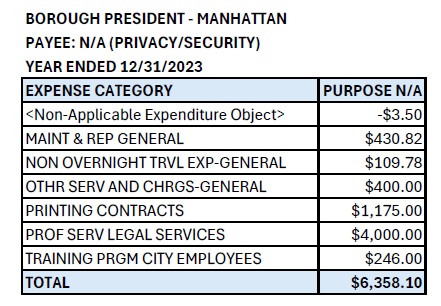
Staten Island: The Conservative
Vito Fossella offers a mere $450 in classified spending. In the realm of opacity, sometimes less is more.
The Main Event: Citywide Classification
But these borough-level activities are merely a prelude to the city’s larger production. Consider $4.2 billion – enough to fund significant public works – simply marked as confidential. More impressively, they’ve managed to make the purposes disappear as well.
When the purpose of $4.1 billion of spending is classified as “blank,” it raises questions about the very nature of public disclosure. The remaining $70 million marked “N/A” almost seems quaint in comparison.
Behind the Numbers
As our investigation continues, one question persists: At what point does privacy protection become opacity by default? We’ve progressed from creative accounting to car service splurges, but $4.2 billion in classified spending suggests a pattern worth examining.
Where’s Our Watchdog?
One might wonder where NYC Comptroller Brad Lander fits into all this. As the city’s fiscal watchdog, surely, he’s raising alarms about $4.2 billion in opaque spending? But perhaps we’re asking too much of someone whose office starred in our previous exposé “Fiscal Follies” for their own creative accounting practices. Or maybe he’s too busy plotting his mayoral campaign to notice a few billion missing explanation marks. Yet, what should we anticipate from a fiscal watchdog holding a master’s degree in social anthropology? He is, at the very least, aptly qualified to examine the cultural patterns of disappearing public funds.
The Credit Card Chronicles
And we’ve barely scratched the surface. Take, for instance, the fascinating world of travel expenses where the payee is listed as “JP Morgan Chase”, but the purpose remains conveniently blank. It’s like submitting an expense report with just a credit card statement and a shrug emoji. Was it a legitimate business dinner or a night at the hotel bar? The public may never know. These transactions raise an important question: If we can’t trust officials to explain a dinner bill, how can we trust them with billions?
Written by Sam Antar
© 2024 Sam Antar. All rights reserved.
